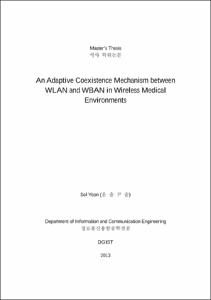An Adaptive Coexistence Mechanism between WLAN and WBAN in Wireless Medical Environments
- Title
- An Adaptive Coexistence Mechanism between WLAN and WBAN in Wireless Medical Environments
- Alternative Title
- 무선 의료 환경을 위한 WLAN 과 WBAN 의 적응 공존 기법
- Author(s)
- Yoon, Sol
- DGIST Authors
- Yoon, Sol ; Park, Kyung Joon ; Lee, Sung Bae
- Advisor
- Park, Kyung Joon
- Co-Advisor(s)
- Lee, Sung Bae
- Issued Date
- 2013
- Awarded Date
- 2013. 8
- Type
- Thesis
- Subject
- Wireless Local Area Network (WLAN) ; Wireless Body Area Network (WBAN) ; Coexistence ; E-health ; CSMA ; 공존성 ; 무선랜 ; 무선 신체 영역 네트워크
- Abstract
-
Electronic health (E-Health) is being recognized as a method to improve the overall health status of the population. For this reason, medical wireless communication technology has been actively studied to realize E-health. Unlike wired communication, the use of wireless communication remains to provide ubiquitous connectivity; it allows better access and enables greater physical mobility to patients. Among the various wireless technologies, WLAN (IEEE802.11/WiFi) and WBAN (IEEE 802.15.4/ZigBee) are widely used for e-healthcare system.
However, interoperability and coexistence between these two heterogeneous networks are becoming key issues. ZigBee is potentially vulnerable to interference by WiFi in the same unlicensed ISM band. Most of all, the significantly different power level and asynchronous
time slots result in significant unfairness between WLAN and WBAN. In this thesis, we focus on the coexistence environment beween WLAN and WBAN for e-healthcare systems in the ISM band.
We propose an adaptive coexistence CSMA mechanism which can mitigate interference and achieve efficiency channel sharing. By using an efficient throughput model, we control and find an appropriate adaptive contention window size of WLAN in order to give transmission
opportunities to WBAN. This proposal can guarantee the required medical-grade QoS of WBAN without any significant degradation of the throughput of WLAN. The simulation results using MATLAB confirm that the proposed algorithm operate to make efficient channel sharing compare with conventional approach. As a result, the proposed coexistence CSMA protocol guarantee reliable healthcare system and provide better QoS of WLAN and WBAN in medical environments. ⓒ 2013 DGIST
- Table Of Contents
-
I. INTRODUCTION 1--
II. RELATED WORK 4--
2.1 Collision of ZigBee and WiFi 4--
2.2 Existing Coexistence Mechanisms 5--
III. BACKGROUND 7--
3.1 Wireless Networking in Healthcare 7--
3.2 IEEE 802.11 WLAN 9--
3.2.1 Physical Layer 9--
3.2.2 MAC Layer 11--
3.3 IEEE 802.15.4 for WBAN 13--
3.3.1 Physical Layer 14--
3.3.2 MAC Layer 15--
IV. PROBLEM STATEMENT 17--
4.1 Critical Data Transmission Issue in WBAN 18--
4.2 Asymmetry of Carrier Sensing 18--
4.3 Collision due to Different Response Time 20--
4.4 Preliminary Simulation 21--
V. PROPOSED ALGORITHM 25--
5.1 Throughput Model per System 25--
5.2 Optimal Contention Window Size 28--
VI. SIMULATION 31--
VII. CONCLUSION 37--
REFERENCES 39
- URI
-
http://dgist.dcollection.net/jsp/common/DcLoOrgPer.jsp?sItemId=000002262504
http://hdl.handle.net/20.500.11750/1339
- Degree
- Master
- Department
- Information and Communication Engineering
- Publisher
- DGIST
- Related Researcher
-
-
Park, Kyung-Joon
- Research Interests Cyber-Physical Systems; Robot Operating System (ROS); Smart Manufacturing
-
- Files in This Item:
-
 기타 데이터 / 583.17 kB / Adobe PDF
download
기타 데이터 / 583.17 kB / Adobe PDF
download
- Appears in Collections:
- Department of Electrical Engineering and Computer Science Theses Master



